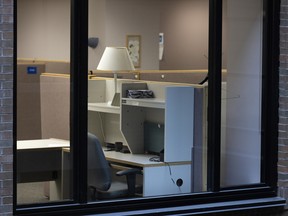By JUSTIN SPIKE

1 of 5
Sgt. 1st Class Balazs Nemeth and his bomb sniffer dog Logan are seen together at the garrison of Explosive Ordnance Disposal and Warship Regiment of the Hungarian Defense Forces in Budapest, Hungary, April 28, 2022. Logan, a two-year-old Belgian shepherd, has received a second chance after being rescued from abusive owners and recruited to serve in an elite military bomb squad. Logan is undergoing intensive training as an explosive detection dog for the Hungarian Defense Forces.
(AP Photo/Bela Szandelszky)
BUDAPEST, Hungary (AP) — Hungary’s military has found a new mission in life for a talented dog who was rescued from abusive owners, recruiting 2-year-old Logan to serve in counterterrorism operations for an elite bomb squad.
The Belgian shepherd is undergoing intensive training as an explosives detection dog for the explosive ordnance disposal and warship regiment of the Hungarian Defense Forces.
At the unit’s garrison on the Danube River in the capital Budapest, Logan receives daily socialization and obedience exercises, and is trained to recognize the smell of 25 different explosive substances.
“He has already started to learn how to smell explosives in a completely homogeneous environment, and he has also started to learn how to search motor vehicles and ships,” said Logan’s trainer, Sgt. 1st Class Balazs Nemeth.
Logan’s new role as a bomb sniffer came only after an early life full of hardships. In 2021, animal welfare officers received a tip that a dog was being abused and held in inhumane conditions at a rural residence in northeastern Hungary. During an on-site inspection, the officers found Logan confined to a one-meter (3-foot) chain and suffering from malnourishment.
Several weeks later, Nemeth, the regiment’s training officer, visited the shelter where Logan was housed and began assessing his suitability for becoming a professional bomb sniffer.
“The moment we met him the first impressions were very positive. We saw a well-motivated dog in relatively good condition and we immediately had confidence in him,” Nemeth said.
In a demonstration at the unit’s garrison, Nemeth opened a case containing two dozen vials of mock explosive materials like C-4, TNT, ammonium nitrate and others, which Logan is trained to detect.
After concealing a small package of explosive in a hidden crevice on one of the regiment’s river boats, Nemeth brought Logan to the training area where he went immediately to work sniffing for the package, which he found within seconds. The dog’s body tensed as he pointed with his nose at the source of the smell, alerting his handler.
The regiment’s commanding officer, Col. Zsolt Szilagyi, said that the increased use of improvised explosive devices by extremist cells since the turn of the millennium have made it necessary to employ new methods for detecting potential bombs.
“This was a challenge to which the military had to respond, and one of the best ways to detect these devices is to use explosive detection dogs,” Szilagyi said. “These four-legged comrades have been supporting the activities of our bomb disposal soldiers.”
Logan, he said, will serve as an inspector of important sites in Hungary, and could be sent along with the country’s military to NATO missions abroad.
While rescued dogs often present challenges in training given their often traumatic backgrounds, Nemeth said he is confident that Logan will be successful and make a valuable addition to the unit.
“Logan is very valuable because about one out of 10,000 rescued dogs is fit for military service, both medically and psychologically,” he said.
Recruiting rescued dogs often reveals their undiscovered capabilities, and allows for them to find a new home where they can thrive, Szilagyi said.
“There are dogs that have great potential but for some reason they have been pushed to the margins,” he said. “We can give these dogs a new opportunity to be placed in a family, so to speak, where they can live a proper life in loving, competent hands and be useful.”

Sgt. 1st Class Balazs Nemeth and his bomb sniffer dog Logan are seen together at the garrison of Explosive Ordnance Disposal and Warship Regiment of the Hungarian Defense Forces in Budapest, Hungary, April 28, 2022. Logan, a two-year-old Belgian shepherd, has received a second chance after being rescued from abusive owners and recruited to serve in an elite military bomb squad. Logan is undergoing intensive training as an explosive detection dog for the Hungarian Defense Forces. (AP Photo/Bela Szandelszky)
BUDAPEST, Hungary (AP) — Hungary’s military has found a new mission in life for a talented dog who was rescued from abusive owners, recruiting 2-year-old Logan to serve in counterterrorism operations for an elite bomb squad.
The Belgian shepherd is undergoing intensive training as an explosives detection dog for the explosive ordnance disposal and warship regiment of the Hungarian Defense Forces.
At the unit’s garrison on the Danube River in the capital Budapest, Logan receives daily socialization and obedience exercises, and is trained to recognize the smell of 25 different explosive substances.
“He has already started to learn how to smell explosives in a completely homogeneous environment, and he has also started to learn how to search motor vehicles and ships,” said Logan’s trainer, Sgt. 1st Class Balazs Nemeth.
Logan’s new role as a bomb sniffer came only after an early life full of hardships. In 2021, animal welfare officers received a tip that a dog was being abused and held in inhumane conditions at a rural residence in northeastern Hungary. During an on-site inspection, the officers found Logan confined to a one-meter (3-foot) chain and suffering from malnourishment.
Several weeks later, Nemeth, the regiment’s training officer, visited the shelter where Logan was housed and began assessing his suitability for becoming a professional bomb sniffer.
“The moment we met him the first impressions were very positive. We saw a well-motivated dog in relatively good condition and we immediately had confidence in him,” Nemeth said.
In a demonstration at the unit’s garrison, Nemeth opened a case containing two dozen vials of mock explosive materials like C-4, TNT, ammonium nitrate and others, which Logan is trained to detect.
After concealing a small package of explosive in a hidden crevice on one of the regiment’s river boats, Nemeth brought Logan to the training area where he went immediately to work sniffing for the package, which he found within seconds. The dog’s body tensed as he pointed with his nose at the source of the smell, alerting his handler.
The regiment’s commanding officer, Col. Zsolt Szilagyi, said that the increased use of improvised explosive devices by extremist cells since the turn of the millennium have made it necessary to employ new methods for detecting potential bombs.
“This was a challenge to which the military had to respond, and one of the best ways to detect these devices is to use explosive detection dogs,” Szilagyi said. “These four-legged comrades have been supporting the activities of our bomb disposal soldiers.”
Logan, he said, will serve as an inspector of important sites in Hungary, and could be sent along with the country’s military to NATO missions abroad.
While rescued dogs often present challenges in training given their often traumatic backgrounds, Nemeth said he is confident that Logan will be successful and make a valuable addition to the unit.
“Logan is very valuable because about one out of 10,000 rescued dogs is fit for military service, both medically and psychologically,” he said.
Recruiting rescued dogs often reveals their undiscovered capabilities, and allows for them to find a new home where they can thrive, Szilagyi said.
“There are dogs that have great potential but for some reason they have been pushed to the margins,” he said. “We can give these dogs a new opportunity to be placed in a family, so to speak, where they can live a proper life in loving, competent hands and be useful.”

Sgt. 1st Class Balazs Nemeth and his bomb sniffer dog Logan are seen together at the garrison of Explosive Ordnance Disposal and Warship Regiment of the Hungarian Defense Forces in Budapest, Hungary, April 28, 2022. Logan, a two-year-old Belgian shepherd, has received a second chance after being rescued from abusive owners and recruited to serve in an elite military bomb squad. Logan is undergoing intensive training as an explosive detection dog for the Hungarian Defense Forces. (AP Photo/Bela Szandelszky)















